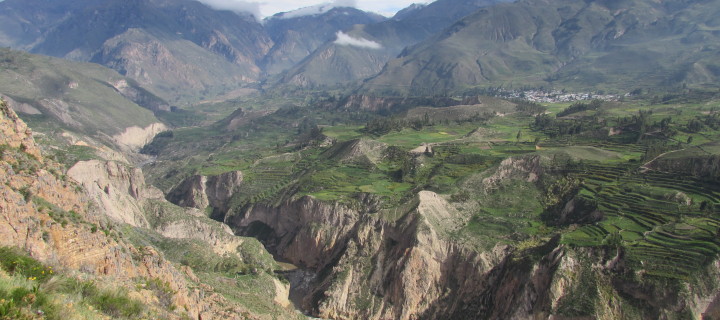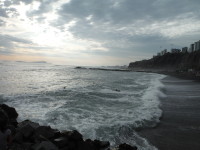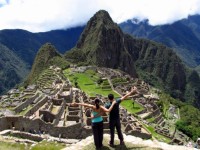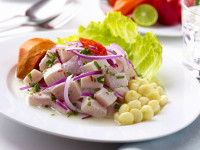Bye bye Bolivia, Hola Peru !
The time goes definitively too fast and we are already leaving Copacabana and the beautiful Lake Titicaca in Bolivia.
Arequipa has been a very special time as we got to meet the family of my friend Zina from Switzerland. 🙂
After a short stop in Puno where we got 2 days to visit this cute city, we arrived in Arequipa where we have been warmly welcomed by Jean-Paul and Pedro, Zina’s brothers. As said in previous articles, nothing is better to visit a city with local people as it changes automatically the experience!
For the first 10 days spent in Peru, our experience in the country has been very positive. People are welcoming, the landscapes are wonderful and the country seems to be a little “healthier” than Bolivia. Maybe there is a little less of corruption? The transportation has been the best so far in south america and the food doesn’t seem to be too bad. I have heard about Peru since a long time back home. Some of my family member went there, I watched documentary on TV and of course my friend Zina is from Peru, I could hear a lot about it which made my desire even bigger to visit the land of the Incas. We can say that so far, we are not disappointed. The only thing is that right now, it is quite cold. The summer is slowly ending and the temperatures at night are quite low, BUT we have thankfully our Alpaca jacket to keep us warm 🙂 As well as some homemade Pisco too. Read below for more info and recipe !
First stop – Arequipa city center
Our first day with Zina’s brothers has been great as they took us around the city and showed us the nice places to see, to eat and drink at, as well as the best views of the city. Arequipa city center in not that big and can be visited in one day.
The city is surrounded by volcanos which can be seen from the center such as the famous El Misti (5,822m) rising behind the cathedral on the Plaza de Armas. More towards the left handside is the Chachani (6,075m) and on the right handside the Pichu Pichu (5,571m). It is possible to climb those volcanos but we did not do so. Arequipa can be categorized as a volcanic place which has been bombarded by eruptions and earthquakes the past centuries! And when we just arrived in the city, a small earthquake had just happened..! Jean-Paul and Pedro are used to it and told us that is normal! Ok well.. Let’s hope that no big ones are gonna come back… Ugh.
Arequipa is very colonial and has beautiful monuments kept intact since the Spanish arrived in 1540.It is also consider being the “white city” due the volcanic stones called “sillar” being seen all over the city.
We first stopped at the majestic white cathedral (made with sillar) lying right at the Plaza the Arma. The colonial style is beautiful and it costs few soles (Peruvian money) to visit it including a guide. We didn’t do it as the weather was beautiful, we thought the better view we can have from it must be definitively from outside.
We also passed by different “Monasterios” that were very important in the past years. There is the graceful Monasterio Santa Catalina that is worth a visit. It is almost having citadels within the city. Today, it has become a place to visit which is nice to do on Tuesday and Thursday evening for special events.
Walking around the center and the narrow streets with Jean-Paul and Pedro have also been great to feel the energy of the city and to observe the inhabitants. We can see that Arequipa has a small cosmopolitan flair with its numerous cafe and good restaurants.
In term of food, it is an amazing place to discover the local dishes that include the Ceviche which is raw fish cooked in lemon and onions, the Americano which is a mix of rice, corn, and the famous pimiento cooked with meat inside, alpaca ribs and the Cuy, that is guinea pig or Cochon d’Inde in French. :-((I didn’t know they would eat those cute animals.. But well, I guess it is part of the culture.
After lunch, after having passed one of the bridge, we arrived in a small market from where we could have a nice view on the city. Arequipa is actually quite big and spread out! On the way back to town, Jean-Paul and Pedro made us try the famous cheese ice cream (Hellado de queso) that surprisingly taste very good.
Otherwise later on in the afternoon, we could taste a good local beer the Cusceña or the Chicha de Jora, a beer made with corn. Peru seems definitively to offer a large choice of local food and drinks.
Music and Pisco, as part of the culture
The day after, we were lucky enough to be part of the grand-mother’s birthday party. 🙂
Ida, the mother, invited all the family to celebrate the 82nd birthday of the abuelita. She told us that it would be something small, but actually, for us is it was not! They invited a music band that was here for almost the entire evening. They played typical Peruvians songs, which I can’t remember the names but all beautiful and perfect to dance some salsa!
The family enjoyed dancing all night and we also enjoyed a lot being part of this traditional Peruvian party. The best part has been to learn how to make Pisco Sour. It is a delicious local cocktail made with eggs, Pisco (coming from the city of Pisco in Peru), sugar and lemon.
We attentively watched Pedro and his uncle’s instructions to finally taste the famous drink. The Pisco Sour is really excellent as a cocktail and here is the link to the recipe in case you would to try it once at home !:-)
What a night ! After having eaten some “Pastel de papas”, veggies and pigs’feet (for Juan only) we went to sleep 2 hours before embarking for a full day trip in the Cañón del Colca.
Cañón del Colca
With small eyes, we woke up at 2:30 am to catch a transfer to the closest town to the canyon called Chivay, 3 hours away from Arequipa, for a full day of discovery through one of the world’s deepest canyons lying at 3191 meters high.
The altitude unfortunately didn’t suit Juan and had to stay in the main town to rest. Ho no poor him. 🙁 The party we had the evening before didn’t help for sure and the best way to recover from nausea in high altitude is to drink coca leaves and rest.
The Coca leaves are extremely helpful for, not only sickness due to the altitude but also headaches, stomachache and are a great stimulant giving energy and more oxygen.
After being all set with the group and the guide in our mini van, the 10 people and I were off towards the valle. We first stopped by the Reserva Nacional Salinas y Aguada Blanca which gives a great overlook on the altiplano (high Andean plateau) over the highest point at 4800m. Not needed to say it was quite cold ! But the view was really amazing.
20 minutes drive later, we have arrived in Chivay and its spectacular valley.Trekking is by far the best way to discover the Colca Canyon but the earthquake I was talking about earlier damaged the road to access it and is now closed for a certain period of time..
However, it didn’t stop us much to have a deep view in the canyon and enjoy the amazing scenery. The highlight also of the Cañón are its many condors flying over our heads. Those majestic animals leave in the Cañón and are specially easy to see during the breeding season, flying together over the land and the Canyon. The main point to see them is the “Cruz del Condor”.
We did several stops on the road towards the national park. First stop has been in a small but typical village where women still wear the traditional clothing and hats. Those typical villages very often lived out of the artisan works that include Peruvian hats, jackets, gloves and other fine souvenirs. The prices are not too high and in my opinion it is totally worth buying a warm pullover made out of alpaca.
The alpaca is indeed the national animal and can be seen all over the places. With local kids for “souvenir picture” but also in the country side where people use them for the eating the grass, for its wool and the confection of clothes but also its meat and many other different things. These are really really cute animals, specially when they are babies 🙂
On the road, it is also easy to spot vicuñas, endangered wild cousins of the llamas that are now protected. They have an amazing soft skin and their wool is used for fine confection.
We also did a stop toward another village called Cabanaconde where we can see several picturesque villages and some pre-inca terraces. The view was simply magical. Some kilometers further were natural thermal baths. The water is usually used for healing the body: arthritis, blood pressure and skin problems. Tourist also come here to enjoy the warm natural water surrounded by the inca trail and the valley.
The Colca Canyon was a great day out and good way to visit the local villages and feel the real Peru. A must do for people traveling around here 🙂
Once back to Arequipa, we had a really good sleep as we were simply exhausted. The last day in Arequipa has been relaxing, walking around with Pedro and visiting some nice spots of Arequipa such the Molino (Water-mill) which is now use as a museum. In the past, people used it to grind corn and seeds. The place was quite and relaxing, it was sunny and warm, what the best way to say good bye to this cute and beautiful town.
We also said good-bye to the family which, somehow became a little part of our family too. Thank you, Jean-Paul, Pedro, Ida and all the rest of the family for the generosity and warm hospitals given to us during our time in Arequipa.
We are now off to Cusco. We look forward to sharing our next article about the Machu Picchu 🙂
Hasta prontito!
Useful information:
Colca Canyon:A boleto touristico needs to be purchased to access the Colca Canyon which is at 70 soles for foreigners or 40 soles for South American and locals. Tours are organised from 1 day to 3 days with trekking.
How to get to Arequipa: Cruz del Sur is a safe and great bus company that travel all over South America, it is well recommended !



























































